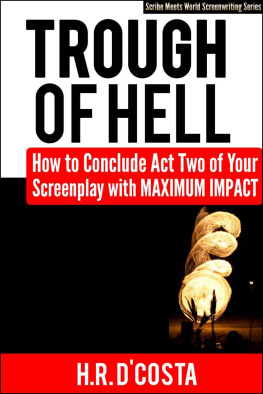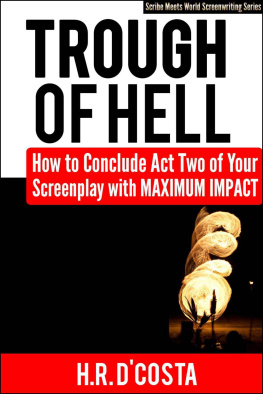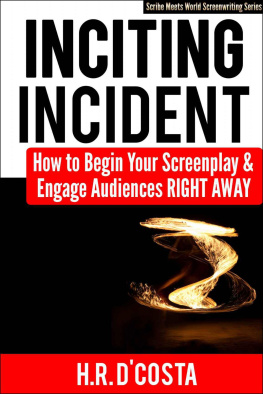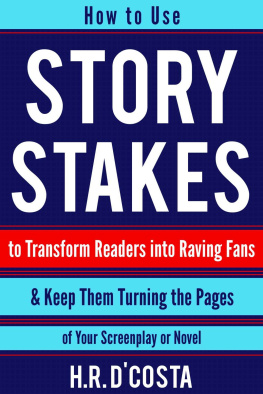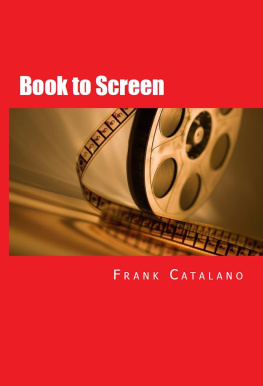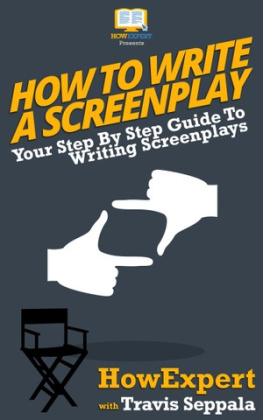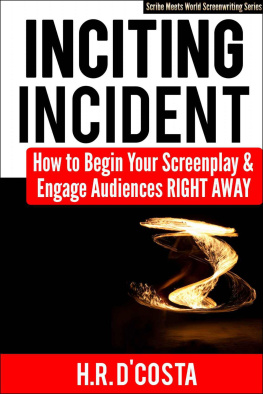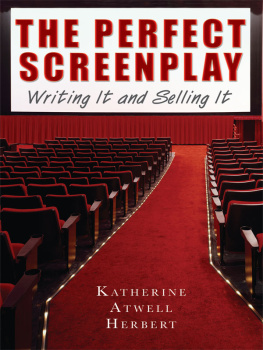H.R. DCosta - Trough of Hell: How to Conclude Act Two of Your Screenplay with Maximum Impact
Here you can read online H.R. DCosta - Trough of Hell: How to Conclude Act Two of Your Screenplay with Maximum Impact full text of the book (entire story) in english for free. Download pdf and epub, get meaning, cover and reviews about this ebook. year: 2014, genre: Detective and thriller. Description of the work, (preface) as well as reviews are available. Best literature library LitArk.com created for fans of good reading and offers a wide selection of genres:
Romance novel
Science fiction
Adventure
Detective
Science
History
Home and family
Prose
Art
Politics
Computer
Non-fiction
Religion
Business
Children
Humor
Choose a favorite category and find really read worthwhile books. Enjoy immersion in the world of imagination, feel the emotions of the characters or learn something new for yourself, make an fascinating discovery.
- Book:Trough of Hell: How to Conclude Act Two of Your Screenplay with Maximum Impact
- Author:
- Genre:
- Year:2014
- Rating:5 / 5
- Favourites:Add to favourites
- Your mark:
Trough of Hell: How to Conclude Act Two of Your Screenplay with Maximum Impact: summary, description and annotation
We offer to read an annotation, description, summary or preface (depends on what the author of the book "Trough of Hell: How to Conclude Act Two of Your Screenplay with Maximum Impact" wrote himself). If you haven't found the necessary information about the book — write in the comments, we will try to find it.
If youre like me, you know how your screenplay or novel* is going to start and end. Maybe not the exact image or line, but youve got a rough idea of what youre going to write. So you begin writing your story with lots of enthusiasm...until you reach the middle, aka Act Two.
Thats where you get stuck. Suddenly, all of your enthusiasm evaporates. Blank pages are scary in general. Blank pages from Act Two, those are downright terrifying. But if you figure out which events end Act Twooften referred to as the all is lost momenteverything else will fall into place. If you do that, youll be writing screenplay or novel pages quickly. Theyll be good pages too. Pages which engage, excite, and enthrall.
So, Whats the Key to Plotting the Perfect All Is Lost Moment?
Its simple: craft a sequence which is filled with pain, emotion, and paradox...what I like to call the heros trough of hell. Combined, these three elements re-engage audiences, right when their interest is about to flag. Thats why its so important to get this plot point right. This writing guide will show you exactly what to do.
With This Screenwriting Guide, Youll Learn:
- how to use 4 different pain types to inflict maximum damage to your hero (and why you should)
- 3 methods to make the trough of hell more emotionally intensewithout altering a single beat of the all is lost moment
- how a hero seems to be the furthest away from his goal, when you and I both know hes about to accomplish it in 15 pages (give or take)
- 7 common ways to end Act Two and how to overcome the unique challenges each presents
- how to enchant audiences by combining multiple trough types
- the trick Peter Jackson used to increase the emotional weight of THE TWO TOWERS
- why the most effective way to hurt your heroeven in an action moviedoesnt involve blood, burns, or bruises
- 5 different forms of betrayal you can use to split your heroes apart
- how to use setups and payoffs to extricate your hero from dicey situations (like capture and death)
- the secret sauce to turning allies into foes (think Dr Nichols in THE FUGITIVE)
- what stuck out the most to Johnny Depp when filming THE CURSE OF THE BLACK PEARL...and why it matters to you, as a screenwriter
- the STAR WARS secret which will help you achieve galactic screenwriting dominion
- 5 clich-free ways to show your heros post-trough distress
- how to pace your story with panache
- how to handle problems specific to thrillers, action movies, comedies, and romantic comedies
Im a big fan of learning by example. So I use plenty of them to illustrate my points. But sometimes examples just arent enough. Thats why Ive also included 8 detailed case studies which should help you put together all the writing secrets youll learn from this book.
All blockbuster films, the case studies include BRIDESMAIDS, THE FELLOWSHIP OF THE RING, ABOUT A BOY, OCEANS 11, and BRAVEHEART.
Never Get Stuck in the Middle of Your Story Ever Again
Conquer Act Two...for good. Write your screenplay with more ease, more speed, and more confidence. Scroll up and buy Trough of Hell today!
*While all the examples come from movies, this writing guide can help authors who are struggling with the middle section of their novels.
H.R. DCosta: author's other books
Who wrote Trough of Hell: How to Conclude Act Two of Your Screenplay with Maximum Impact? Find out the surname, the name of the author of the book and a list of all author's works by series.

